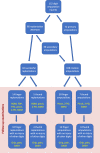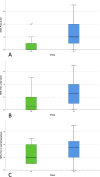Functional outcome after digit replantation versus amputation
- PMID: 35896899
- PMCID: PMC9329495
- DOI: 10.1186/s10195-022-00654-7
Functional outcome after digit replantation versus amputation
Abstract
Background: The success of digit replantation is mainly based on survival rates. The functional outcome as well as the recovery of sensibility are essential parameters for judging the outcome after digit replantation but have been poorly assessed in previous studies.
Patients and methods: Forty-eight patients with 56 complete traumatic digit amputations occurring between 2008 and 2013 returned for a follow-up examination, the earliest being 6 months postoperatively. Each patient's range of motion, fingertip-to-table distance, fingertip-to-palm distance, grip and pinch strengths, static two-point discrimination (2-PD), and Semmes-Weinstein monofilament (SWM) test level were assessed in order to compare functional outcome and recovery of sensibility between successful replantation (n = 19) and primary or secondary amputation (n = 37). Subjective assessments of the pain level and function of the upper extremity were performed using the numerical rating scale and the DASH score, respectively.
Results: Replanted digits achieved 58% of the median total range of motion of the corresponding uninjured digits. Grip and pinch strength were not significantly different after thumb or finger replantation or amputation. Recovery of sensibility was excellent after replantation, with a median static 2-PD of 5 mm and a reduction of pressure sensibility of two levels of the SWM test compared to the contralateral side. After amputation, the median static 2-PD was also very good, with a median value of 6 mm and a reduction of pressure sensibility of only one level according to the SWM test. There was significantly less pain after replantation at rest (p = 0.012) and under strain (p = 0.012) compared to patients after amputation. No significant differences were observed in the DASH score between the two groups.
Conclusion: Comparable functional results and sensory recovery but significantly less pain at rest and under strain can be expected after digit replantation when compared to digit amputation.
Level of evidence: IV.
Keywords: Amputation; Digit; Functional outcome; Replantation; Sensitive recovery.
© 2022. The Author(s).
Conflict of interest statement
The local ethical committee of the University of Tuebingen, Germany approved the study (project number 006/2013B02). No individual person’s data are presented in the manuscript. The datasets used and analyzed during the current study are available from the corresponding author on reasonable request. The authors declare that they have no competing interests. There was no financial support for this work.
The authors declare that they have no competing interests.
Figures







References
-
- Malt RA, McKhann C. Replantation of severed arms. JAMA. 1964;189:716–722. - PubMed
-
- Komatsu S, Tamai S. Successful replantation of a completely cut-off thumb: case report. Plast Reconstr Surg. 1968;42:374–377.
-
- Hadley SR, Capo JT. Digit replantation the first 50 years. Bull Hosp Jt Dis. 2015;73(2):148–155. - PubMed
-
- Sud V, Freeland AE. Skeletal fixation in digital replantation. Microsurgery. 2002;22(4):165–171. - PubMed
-
- Kwon SH, Lao WW, Hsu AT, et al. The preferred management of a single-digit distal phalanx amputation. J Reconstr Microsurg. 2020;36(4):301–310. - PubMed
MeSH terms
LinkOut - more resources
Full Text Sources
Medical
Research Materials

